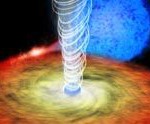Tag Space & astronomy
IceCube building goals exceeded at South Pole
As the 2008-09 Antarctic drilling season concludes, the IceCube Neutrino Observatory is on track to be finished as planned in 2011.
Associate dean advises NASA on human challenges in space programs
A UW–Madison associate dean is part of a committee advising NASA on issues related to a new space program that will send human astronauts to Mars.
Newly born twin stars show surprising differences
The analysis of the youngest pair of identical twin stars yet discovered has revealed surprising differences in brightness, surface temperature and possibly even the size of the two.
Milky Way’s infrared portrait gives new view of galaxy
Astronomers have obtained an entirely new perspective of our home galaxy: a complete mosaic portrait of the Milky Way in infrared light, a picture that when printed measures 180 feet long by 4 feet wide.
Astronomers witness the birth of a supernova
An international team of astronomers, acting on a tip from a NASA satellite that serves as an early warning system for the most violent astronomical events, has caught a supernova in the act.
Curiosities: Why do we need leap days?
Leap days appear every four years or so, including this year, and they are needed because one orbit around the sun does not occur in an exact number of days, says Jim Lattis, director of UW Space Place, in the UW–Madison astronomy department.
UW space science technology powers Google Earth images
Satellite images provide a dramatic view of the Earth and its atmosphere. For timely views of winter weather in Wisconsin or wild fires in California, Google Earth users can now access the most recent high-quality satellite images generated at the Space Science and Engineering Center.
Washburn Observatory to close for renovations
Washburn Observatory, which sits along Observatory Drive on the University of Wisconsin–Madison campus, will close at the end of October for remodeling and renovations.
Curiosities: What is the surface of the Sun like?
“Technically, there is no surface of the Sun,” says UW–Madison’s Sanjay Limaye. The senior scientist and educator with the Space…
Jets from neutron star rival those made by black holes
A team of astronomers led by a UW–Madison scientist has found that neutron stars produce jets of energy and matter that rival those produced by black holes.
With a big assist from NASA, UW-Madison launches astrobiology push
With the help of a $6.5 million grant from NASA, Wisconsin researchers will join the hunt for extraterrestrial life and early life on Earth by developing techniques and instruments to read the chemical signatures living organisms leave in rocks and minerals.
Preparing for better weather forecasts
UW–Madison scientist Allen Huang is at the forefront of preparations for new satellite instruments and the predicted data deluge.
Space Place unveils nifty new exhibits
On Friday, Nov. 10, the University of Wisconsin–Madison's Space Place will unveil three new exhibits about Wisconsin astronomers' explorations of the heavens.
ResearchChannel programs available to Charter Digital Cable subscribers
Subscribers to Charter Digital Cable now have access to University of Wisconsin–Madison programming on ResearchChannel as video on demand.
Physicists say multi-million dollar experiment advancing smoothly
An international team of scientists led by the Fermi National Accelerator Laboratory, or Fermilab, today described early results from a $170 million project that seeks to better understand neutrinos, the elusive subatomic particles that have intrigued physicists for decades.
Giant optical telescope in South Africa comes online
Five years after breaking ground on a South African mountaintop near the edge of the Kalahari desert, astronomers today released the first images captured by the Southern African Large Telescope (SALT), now the equal of the world's largest optical telescope and a prized window to the night skies of the southern hemisphere.
Countdown to new Space Place launch this weekend
Astronomy buffs of all ages are invited to celebrate the launch of Space Place, UW–Madison's astronomy outreach center, at its new Villager Mall location on Sunday, Aug. 28. Opening week activities continue through Thursday, Sept. 1 and are free and open to the public.
Galactic survey reveals a new look for the Milky Way
With the help of NASA's Spitzer Space Telescope, University of Wisconsin astronomers have conducted the most comprehensive structural analysis of our galaxy and have found tantalizing new evidence that the Milky Way is much different from your ordinary spiral galaxy.
UW-Madison instilling science literacy in South Africa
In November, representatives from UW–Madison will attend the inauguration of the southern hemisphere's largest telescope, the Southern African Large Telescope (SALT). UW–Madison is one of nearly a dozen international institutions that partnered with the South African government to build SALT, including universities in Russia, Poland, New Zealand, Germany and the United States.
Moving a multi-ton space machine
As the UW Space Place prepares for a late-June move to Villager Mall, it faces the daunting task this week of relocating its star attraction: an enormous space observatory weighing several thousand pounds.







